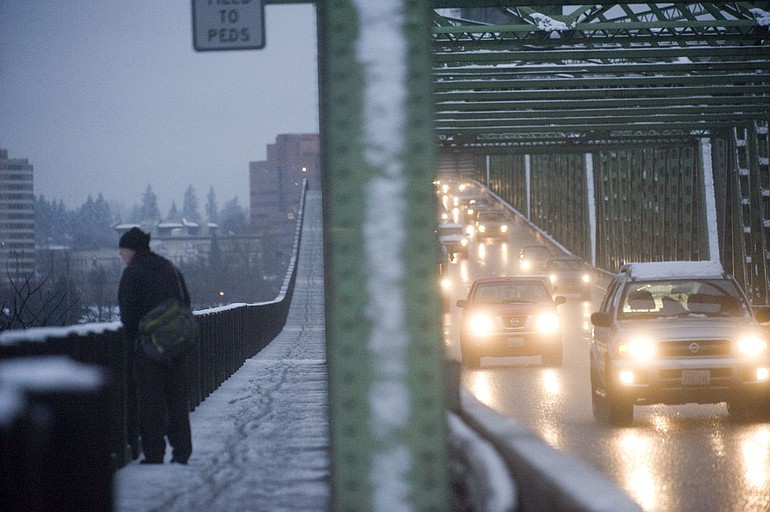John Charles is pitching an alternative to Clark County commuters irritated by the idea of paying a toll on a new bridge across the Columbia River: Tolls everywhere.
He’s not kidding.
Charles, president of the Cascade Policy Institute, a free-market think tank in Portland, has been pushing a market-based solution to the Portland-Vancouver area’s traffic problem.
He envisions a system of electronic tolling on all major highways in the metro area. Converting to a variable tolling system, which has yet to be tried on such a large scale in a major urban area, would enact a sliding scale that imposes the highest charges at peak times and places. Charles said the payoff will come in smooth-flowing traffic with minimal public investment.
“If people experienced it for one week, they would never go back to the system we have today,” he said. “It would be like going from dial-up to high-speed internet.”
Charles, who has worked on congestion pricing for 19 years, acknowledged that people initially view the idea of all-highway tolling as far-fetched. Charles said the initial skepticism usually erodes after he makes the case.
“You’d be surprised how open-minded people can get,” he said. “They go from ‘no’ to ‘maybe.’”
Charles sees a prime opportunity to make the case for a wholesale rethinking of the region’s highway system in light of two major new developments: The proposed multibillion-dollar Columbia River Crossing, combined with a new Oregon state law requiring one congestion pricing pilot project in the Portland area within three years.
He believes Vancouver commuters could be his most receptive audience.
Rather than tolling just one location on the interstate system — the only area that directly targets Clark County commuters — Charles said a ubiquitous pricing system throughout the Portland area would be more equitable, efficient and probably cheaper overall than the kind of project embodied by the Columbia River Crossing.
“My proposal, frankly, is easier to sell,” he said.
Not necessarily, according to Jim Whitty, manager of the Oregon Department of Transportation’s Office of Innovative Partnerships and Alternative Funding.
“There are some people who use the freeway every day, and use neighborhood streets and boulevards less,” Whitty said. “The question is, should they bear the burden for the entire system or should everybody bear the burden?”
Even so, he said the idea is not out of the realm of possibility.
“The state’s in a position right now where funding has gotten very dear,” Whitty said. “Given the trends, that funding will be more difficult in the future.”
Charles suggests placing electronic tolls along a few key points on Interstate 5 from Ridgefield to Wilsonville, Ore.; on Interstate 84 as far east as Troutdale, Ore.; all of Interstates 205 and 405; Highway 217 from Beaverton, Ore. to Tigard, Ore.; and Highway 26 from downtown Portland to Forest Grove, Ore. Cars would travel with electronic transponders, sensed by overhead gantries.
The institute recently commissioned a study by Oregon economist Randall Pozdena, who makes the case that tolling roads where and when they’re actually used is a more sensible funding mechanism than today’s gas tax.
Charles equates the current road-funding system to a hypothetical grocery tax. Once the tax is paid, the items would be available for the taking on the store’s shelves.
“You’d have a mob scene,” he said.
Which loosely describes the morning and evening rush hour across the Interstate 5 Bridge.
Unlike a grocery store, where items are priced at the point of consumption, the capacity of a roadway is not directly connected to the revenue that pays for it, Pozdena said. Even though it seems “free,” there is actually a cost. It comes in the incremental congestion caused by each vehicle that squeezes into a freeway lane.
“Nobody comes up to your car, knocks on your window and says, ‘You just slowed the other vehicles in the stream here by 5 miles per hour,’” Pozdena said.
He noted that toll roads are nothing new in the Midwest or on the East Coast. Ubiquitous tolling on an interconnected network of roadways hasn’t been tried anywhere, although Pozdena said a network pricing plan is about 18 months away from enactment in The Netherlands.
Pozdena sees nothing revolutionary in the concept of pricing highways. To him, the wonder is why we don’t.
“Why is it that we tolerate the price of tomatoes being so much higher in the winter, when they’re scarce, than in the summer?” he said. “We don’t complain about that. We don’t complain about the use of an Internet service being more expensive during the day than at night.”
Pozdena sees evidence of efficient pricing everywhere.
You pay more for evening tickets than you do for movie matinees. You pay more to fly during Christmas, or for courtside tickets to a Blazers game. When it comes to allocating resources on the basis of supply and demand, Pozdena said, efficient pricing of highways makes perfect sense.
“Nothing’s scarcer than concrete in the morning,” he said.
Pozdena cited an experiment he conducted in Seattle in which each of 500 motorists were endowed with $2,000 at the beginning of a two-year trial, then tracked with transponders. They were docked each time they traveled during rush hour.
Total vehicle-miles traveled dropped by 9.5 percent.
“All of a sudden, carpooling makes more sense,” Pozdena said. “You may choose to telecommute. You may be able to change the time of your departure or arrivals, if you’ve got a friendly employer. We end up using the same concrete more efficiently.”
Erik Robinson: 360-735-4551, or erik.robinson@columbian.com.



